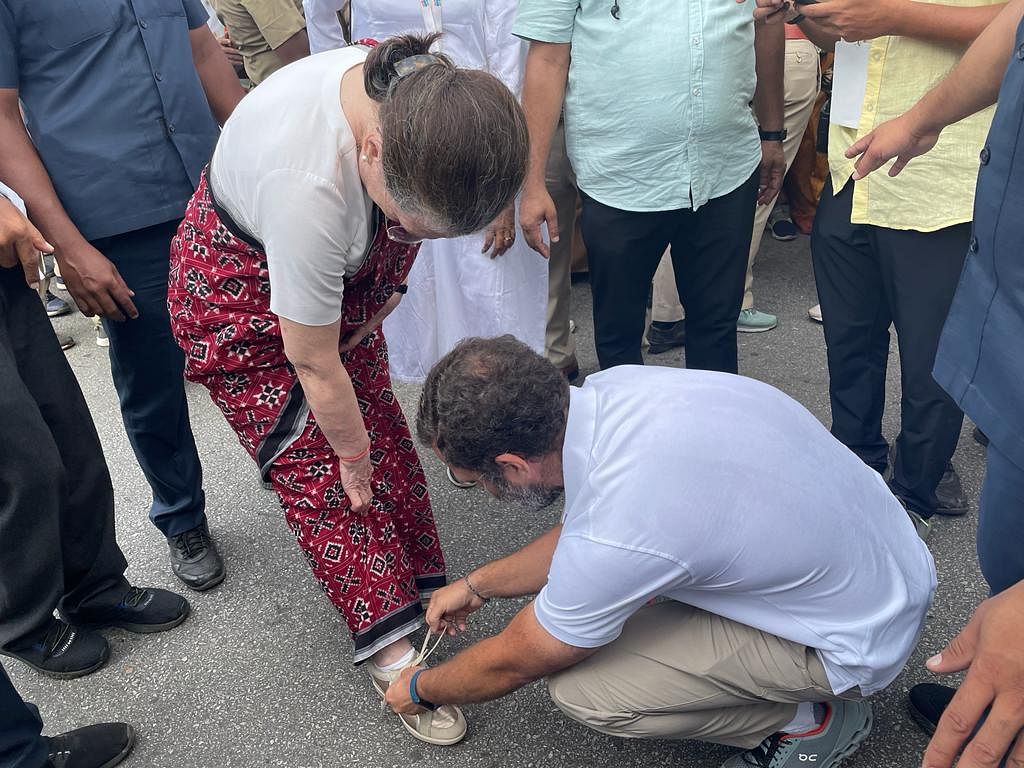As Dalits and the forward Lingayat community leaders sat together for a sahabhojana (common lunch) at Badanavalu village in Mysuru district in Karnataka, history was created. It was after 29 long years that the two communities in the village had come together—the parting of ways had been bitter after three Dalits were brutally killed in March 1993. Credit for bringing together the two communities and for opening up movement between the two hamlets goes to the ongoing ‘Bharat Jodo Yatra’.
It was not just sharing a lunch together. A 180 metre stretch of road was also laid in the village to connect the two estranged communities. The pathway had remained closed since 1993.
Rahul Gandhi, along with children from all communities in the village, laid the last stretch of the road with multi-coloured blocks of brick and aptly named it ‘Bharat Jodo Road’. Communication between the Dalits and the Lingayats in the village had broken off following a dispute over the Dalits’ entry into the Siddeshwara temple in the village. Dalits, who were debarred from entering the temple by the upper castes, had taken up the issue with the authorities concerned, who eventually facilitated their entry.
Angered by this, three Dalits were hacked to death on 25 March 1993, while they were returning from the temple. Of the 23 accused in the killings, 20 were convicted following a CBI inquiry and the court sentenced them to life imprisonment. The ‘Bharat Jodo Yatra’, which has moved through the Old Mysuru areas of Chamarajanagar, Mysuru and Mandya and is inching towards north Karnataka districts of Ballari and Raichur, has been living up to its spirit of cementing relations.
In Mysuru, Rahul Gandhi visited a temple, a mosque and a church and sought the blessings of Suttur mutt seer Swami Shivarathri Desikendra, who represents the Lingayats. However, the major takeaway in the Karnataka leg of the Yatra so far has been the overwhelming response from the civil society. With the Congress trying to position the yatra as a platform to connect with people rather than treating it as a party event, the response from members of the civil society and even apolitical individuals to the walkathon has caught even the die-hard optimists in the party by surprise.
On the first day of the yatra in Karnataka, noted writer Devanooru Mahadeva, whose recent book that exposes the ideology of RSS has been making waves, was among those who welcomed the Yatris into Karnataka. Cultural activist Ganesh Devy and political activist Yogendra Yadav along with Mahadeva have ensured that Rahul Gandhi holds interactions with one group or the other during the breaks he takes from 10. 30 am to 3 pm, which has been thematically arranged.
The yatris have been walking around 25 km every day and Rahul Gandhi’s pace has been the talking point among both yatris and the onlookers. Some of the elderly leaders and yatris do find it difficult to keep up with him and are often left behind. Painting the compound wall of a government school in Badanavalu on Gandhi Jayanti, biting into sugarcane in Pandavapura in Mandya district, quizzing independent journalists on how difficult it is for them to work in the present atmosphere, Rahul Gandhi seems to be liking every moment of the Yatra and his interactions.
Will the Bharat Jodo Yatra bring electoral dividends? Karnataka politics is no stranger to yatras taken out by political parties with the state unit of the Congress having undertaken the highest number of them. The most fruitful for the party was the Panchajanya Yatra (team of five leaders) undertaken by the then state Congress president S. M.
Krishna (now in BJP) ahead of the Assembly polls in 1999. The party had a landslide victory in the election, winning 179 seats, a mark which the Congress has not been able to touch since then. In 2010, former chief minister Siddaramaiah had undertaken one from Bengaluru to Ballari after he was challenged by mining czar and minister in the then BJP government G.
Janardhana Reddy on the floor of the Assembly. In 2013, the Congress returned to power with Siddaramaiah as the CM, who was the only person to complete five years in office after S. M.
Krishna. Rahul Gandhi’s role as a peace-broker between the Lingayats and Dalits in Badanavalu will help the party, say local Congress leaders. The Lingayat community had drifted away from the party after a Lingayat chief minister Veerendra Patil was sacked in 1990.
The Lingayats then turned to former chief minister Ramakrishna Hegde, who had cultivated the BJP by then, and this helped transfer Lingayat votes to the BJP. In 2000, BJP’s Lingayat strongman B. S.
Yediyurappa emerged as the rallying point for the community and the Congress has been trying hard to break his stranglehold over the community. While Dalits had earlier sided with the Congress, in recent years their support has been divided between the Congress and the BJP. The overwhelming response to the ‘Bharat Jodo Yatra’ and the huge turnout at the birthday celebrations of former chief minister Siddaramaiah in August have rattled the BJP, which is struggling to counter the Congress party’s ‘PayCM’ campaign against corruption in the “40 per cent sarkara”.
As an answer to the ‘Bharat Jodo Yatra’, the BJP is planning to hold a rally of the Other Backward Classes in Kalaburagi on October 30. By then, the ‘Bharat Jodo Yatra’ will have left the state. .
From: nationalheraldindia
URL: https://www.nationalheraldindia.com/india/bharat-jodo-yatra-healing-old-scars-in-karnataka



